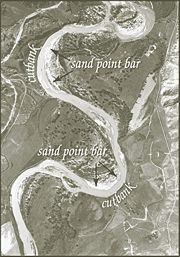
Cut bank (geology)
Encyclopedia

Erosion
Erosion is when materials are removed from the surface and changed into something else. It only works by hydraulic actions and transport of solids in the natural environment, and leads to the deposition of these materials elsewhere...
al feature of streams
STREAMS
In computer networking, STREAMS is the native framework in Unix System V for implementing character devices.STREAMS was designed as a modular architecture for implementing full-duplex I/O between kernel or user space processes and device drivers. Its most frequent uses have been in developing...
. Cut banks are found in abundance along mature or meandering streams, they are located on the outside of a stream bend, known as a meander
Meander
A meander in general is a bend in a sinuous watercourse. A meander is formed when the moving water in a stream erodes the outer banks and widens its valley. A stream of any volume may assume a meandering course, alternately eroding sediments from the outside of a bend and depositing them on the...
. They are shaped much like a small cliff
Cliff
In geography and geology, a cliff is a significant vertical, or near vertical, rock exposure. Cliffs are formed as erosion landforms due to the processes of erosion and weathering that produce them. Cliffs are common on coasts, in mountainous areas, escarpments and along rivers. Cliffs are usually...
, and are formed by the erosion of soil as the stream collides with the river bank. As opposed to a point bar
Point bar
A point bar is a depositional feature of streams. Point bars are found in abundance in mature or meandering streams. They are crescent-shaped and located on the inside of a stream bend, being very similar to, though often smaller than towheads, or river islands.Point bars are composed of sediment...
which is an area of deposition, a cut bank is an area of erosion
Erosion
Erosion is when materials are removed from the surface and changed into something else. It only works by hydraulic actions and transport of solids in the natural environment, and leads to the deposition of these materials elsewhere...
.
Typically, cut banks are nearly vertical and often expose the roots of nearby plant life. Often, particularly during periods of high rainfall and higher-than average water levels, trees and poorly placed buildings can fall into the stream due to mass wasting
Mass wasting
Mass wasting, also known as slope movement or mass movement, is the geomorphic process by which soil, regolith, and rock move downslope under the force of gravity. Types of mass wasting include creep, slides, flows, topples, and falls, each with its own characteristic features, and taking place...
events. Given enough time, the combination of erosion along cut banks and deposition along point bars can lead to the formation of an oxbow lake
Oxbow lake
An oxbow lake is a U-shaped body of water formed when a wide meander from the main stem of a river is cut off to create a lake. This landform is called an oxbow lake for the distinctive curved shape, named after part of a yoke for oxen. In Australia, an oxbow lake is called a billabong, derived...
.
Not only are cut banks steep and unstable, they are also the area of a stream where the water is flowing the fastest and the deepest, making them rather dangerous. Geologically speaking, this is known as an area of high-energy.
Material eroded here is deposited downstream in point bar
Point bar
A point bar is a depositional feature of streams. Point bars are found in abundance in mature or meandering streams. They are crescent-shaped and located on the inside of a stream bend, being very similar to, though often smaller than towheads, or river islands.Point bars are composed of sediment...
s.

